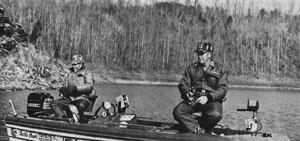Charlie Brewer — The father of finesse fishing
Published 12:00 am Thursday, April 16, 2009

- Former Kentucky Afield Television show host Hope Carleton (left) and Charlie Brewer (right) fish the Slider method on Dale Hollow Lake in 1975. Brewer's Slider worm launched the finesse fishing revolution in the early 1970s.
My dad came home from a boat show in Louisville back in the late 1970s with a small plastic tackle box, a 5-foot top-of-the-line light power graphite rod and a new Shakespeare spinning reel spooled with 6-pound line. Excitement radiated from him as he couldn’t wait to try his new gear in the distillery lakes close to our home near Bardstown, Kentucky – an area that produces a generous share of the world’s bourbon.
Similar in size to those used for cigars, the small tackle box came with five compartments: one filled with funny-looking leadheads and the other four filled with small, 4-inch straight-tailed worms. Black worms filled one compartment; grape worms lay in another, while brown with an orange tail and motor oil filled the other two.
He bought the new gear from a man at the boat show who told him all about this new system that caught bass in the toughest conditions. The man said this new technique would excel in the weedy, shallow and clear distillery lakes near our home if he just stuck to it long enough to learn it.
My dad caught many bass with his new gear, but soon he could not find the small tackle box and rod because I had them on the shore of one of those distillery lakes. I learned to consistently catch bass year-round using light line and 4-inch worms and profited from it enormously. The knowledge gained provided the foundation for my later writings about bass fishing.
The man at the boat show was Charlie Brewer and he died 9 years ago this week. In the mythology of bass fishing, finesse techniques of using light line, subtle lures and spinning tackle to tempt spooky clear-water bass belongs to the deep, crystalline lakes of California. In reality, these techniques belong to Charlie Brewer.
He developed the Slider system to fool black bass in what he called the “tough, mean” reservoirs of east Tennessee, southeast Kentucky and the Highland Rim of middle Tennessee. Brewer’s Slider Worm launched the finesse revolution 20 years before most heard the term.
Brewer returned from World War II to Lawrenceburg, Tennessee and opened a radio and TV repair shop with knowledge gained in the South Pacific. A natural-born tinkerer, Brewer grew weary of the long, fishless hours throwing a baitcaster spooled with black nylon line and a crankbait such as the Heddon River Runt. He figured there had to be a better way to catch bass more consistently when they aren’t active and chasing lures.
Brewer developed a unique leadhead designed to plane in the water, not fall to the bottom like a smooth rock. He also poured his own slender 4-inch ringed worms with an egg sack that tapered to a paddle tail. He cast these worms on short graphite or graphite composite rods with a Tennessee handle for increased sensitivity. He removed the bail from the reels to increase casting distance for his 1/16- to 1/4-ounce leadheads and diminutive worms. He founded the Crazy Head Lure Company in 1970, now known as the Charlie Brewer Slider Company.
The key to Brewer’s system is presentation. The Slider method is designed to find bass suspended in the water column or hanging just above the bottom. Bass in clear-water lakes such as Lake Cumberland, Laurel River Lake and Dale Hollow Lake suspend most of the time during the day, especially in summer and winter. Suspended bass represent one of the toughest bass fishing situations.
The original Crazy Head was a flat-bottomed leadhead that came through the water in a straight line on the retrieve. Brewer later developed other styles of flat-sided heads and bullet shaped ones, but the basic concept remains. The heart of his Slider system is manipulating the speed of the retrieve and the weight of the leadhead until you hit the combination of depth and speed bass want that particular day.
This may require cutting some weight off the Slider head till it weighs just 1/32-ounce or flattening it to slow the rate of fall. Find a likely fish-holding structure, such as a channel point laden with boulders or stumps. Cast parallel to the structure and count to ten. Reel the Slider worm with a rhythmic, but slow cadence and watch your line intently. Keep counting down and reeling slowly until you get a rapid peck or nip from a bluegill, baby bass or crappie. This is the activity zone. Count down a little more on the next cast and you’ll be in bass.
Once you find the depth and speed they want, you can fish similar areas all over the lake and catch fish all day. The Slider worm resembles a minnow more than anything and fish can’t help themselves. It is simple and ingenious. Plus, light to medium-light spinning rods and 6-pound line make 2-pounders feel like trophies. It is simply a fun and relaxing way to catch bass after bass, plus the occasional trophy bluegill, crappie, walleye and even freshwater drum.
Brewer also believed bass anglers do way too much running and gunning instead of fishing. He felt folks should pattern their fish close-by and focus more on technique than covering water. Brewer relates in his touchstone book “Charlie Brewer on Slider Fishing” that some of his best fishing days stemmed from engine trouble that forced him to scour the fishy-looking areas near the ramp. This also saves gas and wear and tear on the big motor.
All you need is a small box or a paper bag with a few colors of Slider worms, some Slider heads, a pair of sidecutter and needlenose pliers and knowledge. Largemouth, smallmouth and spotted bass gobble them up with the same abandon now as they did when Sliders first hit the market 30 years ago.
Author Lee McClellan is an award-winning associate editor for Kentucky Afield magazine, the official publication of the Kentucky Department of Fish and Wildlife Resources. He is a life-long hunter and angler, with a passion for smallmouth bass fishing.
The Kentucky Department of Fish and Wildlife Resources manages, regulates, enforces and promotes responsible use of all fish and wildlife species, their habitats, public wildlife areas and waterways for the benefit of those resources and for public enjoyment. Kentucky Fish and Wildlife, an agency of the Tourism, Arts and Heritage Cabinet, has an economic impact to the state of $4.5 billion annually. For more information on the department, visit our web site at fw.ky.gov.






